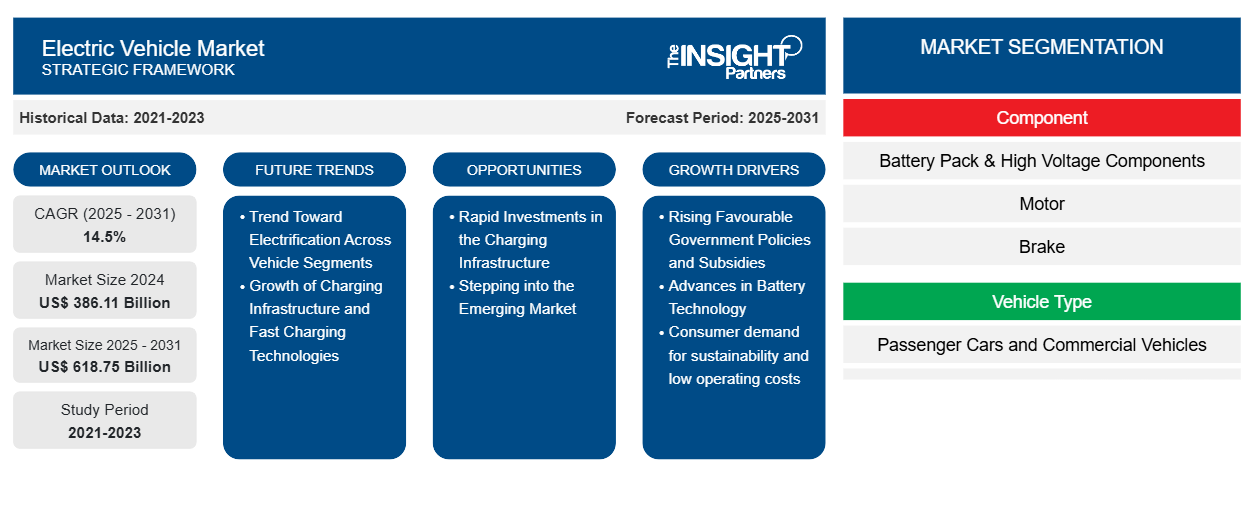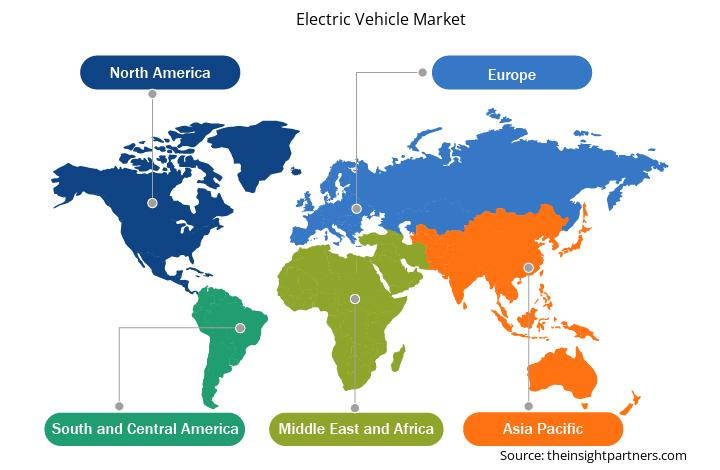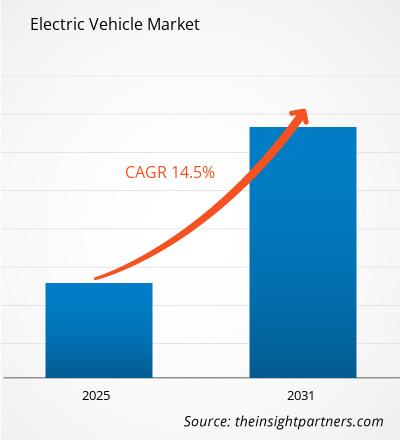电动汽车市场规模预计将从 2024 年的 3861.1 亿美元增至 2031 年的 6187.5 亿美元;预计预测期内复合年增长率为 14.5%
电动汽车市场涵盖按组件(电池组和高压组件、电机、制动器、车轮和悬架、车身和底盘、低压电动等)、按车辆类型(乘用车和商用车)、按推进类型(电池电动汽车、混合动力电动汽车和插电式混合动力电动汽车)、按驱动类型(全轮驱动、前轮驱动和后轮驱动)和地理区域进行的分析
报告目的
The Insight Partners 的《电动汽车市场》报告旨在描述当前形势和未来增长、主要驱动因素、挑战和机遇。这将为各种业务利益相关者提供见解,例如:
- 技术提供商/制造商:了解不断变化的市场动态并了解潜在的增长机会,从而能够做出明智的战略决策。
- 投资者:对市场增长率、市场财务预测以及整个价值链中存在的机会进行全面的趋势分析。
- 监管机构:监管市场政策和警察活动,旨在最大限度地减少滥用行为,维护投资者的信任和信心,维护市场的完整性和稳定性。
电动汽车市场细分
成分
- 电池组和高压元件
- 发动机
- 制动
- 车轮和悬架
- 车身和底盘
- 低压电气
- 其他的
车辆类型
- 乘用车和商用车
推进类型
- 纯电动汽车
- 混合动力电动汽车和插电式混合动力电动汽车
驱动器类型
- 全轮驱动
- 前轮驱动
- 后轮驱动
定制此报告以满足您的需求
您可以免费定制任何报告,包括本报告的部分内容、国家级分析、Excel 数据包,以及为初创企业和大学提供优惠和折扣
电动汽车市场:战略洞察

-
获取此报告的关键市场趋势。这个免费样品将包括数据分析,从市场趋势到估计和预测。
电动汽车市场增长动力
- 政府优惠政策和补贴不断增加:例如,美国联邦政府设定了到 2030 年在美国销售的所有新车中一半实现零排放的目标。此外,美国政府计划建立 500,000 个充电器的公平网络,以帮助所有美国人都能使用电动汽车。在预测期内,政府的优惠政策不断增加,推动了电动汽车市场的销售。此外,由于全球对零排放汽车的认识不断提高,全球电动汽车销量不断增加,推动了市场增长。根据国际能源署 2023 年的报告,电动汽车销量在 2023 年达到约 1400 万辆,与去年的 2022 年相比增长了 35%。
- 电池技术的进步:电池技术最重要的进步是降低成本、提高能量密度和延长电动汽车的续航里程。锂离子和固态电池的开发仍在继续,而充电基础设施的创新使电动汽车对主流消费者来说更加实惠和实用。随着电池技术的进步,电动汽车的性能、可负担性和可及性将继续推动市场增长。
- 消费者对可持续性和低运营成本的需求:消费者开始更加关注环境问题,寻求传统老式汽油车的更清洁替代品。电动汽车的环境优势包括低碳排放,以及降低维护成本,例如更少的换油需求和更少的移动部件,这也是主要卖点。可用性的提高和成本的降低使电动汽车更容易被普通消费者接受。
电动汽车市场未来趋势
- 各个汽车领域都呈现电气化趋势:电动汽车市场正在从传统的乘用车扩展到其他各个领域,例如商用车(电动卡车、公交车、送货车)和豪华电动汽车。制造商越来越多地强调在更广泛的汽车类别中提供电动车型,从紧凑型汽车到 SUV 和高性能跑车。电动汽车对不同类型的消费者(包括车队运营商、企业和有环保意识的买家)的吸引力不断扩大,这是一种趋势。
- 充电基础设施和快速充电技术的发展:充电基础设施的发展对于支持电动汽车的广泛普及至关重要。扩大公共和私人充电网络以及采用超快速充电器或无线充电等快速充电解决方案的趋势日益流行。充电站可用性的增加和再次充电时间的减少减轻了里程焦虑和使用此类车辆的不便。
电动汽车市场机会
- 充电基础设施的快速投资:政府对电动汽车充电基础设施的投资不断增加,在预测期内为电动汽车市场创造了巨大的需求。例如,2024 年 8 月,美国联邦政府通过美国国家电动汽车基础设施 (NEVI) 和充电和加油基础设施 (CFI) 自由裁量补助计划为电动汽车充电基础设施建设拨款 75 亿美元。因此,全球对电动汽车充电基础设施的投资不断增加,推动了电动汽车市场的增长。
- 进军新兴市场:虽然电动汽车在发达市场已得到广泛采用,但新兴市场仍具有巨大的增长潜力,尤其是在中国、印度和拉丁美洲等国家。随着这些地区城市化程度不断提高,中产阶级不断壮大,对廉价、环保的交通解决方案的需求也在不断增长。对于能够提供符合当地需求的经济高效的电动汽车车型(例如紧凑型城市汽车、两轮车或电动嘟嘟车)的电动汽车制造商来说,这些市场潜力巨大。
电动汽车市场区域洞察
Insight Partners 的分析师已详细解释了预测期内影响电动汽车市场的区域趋势和因素。本节还讨论了北美、欧洲、亚太地区、中东和非洲以及南美和中美洲的电动汽车市场细分和地理位置。

- 获取电动汽车市场的区域特定数据
电动汽车市场报告范围
| 报告属性 | 细节 |
|---|---|
| 2024 年的市场规模 | 3861.1亿美元 |
| 2031 年市场规模 | 6187.5亿美元 |
| 全球复合年增长率(2025 - 2031) | 14.5% |
| 史料 | 2021-2023 |
| 预测期 | 2025-2031 |
| 涵盖的领域 |
按组件
|
| 覆盖地区和国家 |
北美
|
| 市场领导者和主要公司简介 |
|
电动汽车市场参与者密度:了解其对商业动态的影响
电动汽车市场正在快速增长,这得益于终端用户需求的不断增长,这些需求源于消费者偏好的不断变化、技术进步以及对产品优势的认识不断提高等因素。随着需求的增加,企业正在扩大其产品范围,进行创新以满足消费者的需求,并利用新兴趋势,从而进一步推动市场增长。
市场参与者密度是指在特定市场或行业内运营的企业或公司的分布情况。它表明在给定市场空间中,相对于其规模或总市场价值,有多少竞争对手(市场参与者)存在。
在电动汽车市场运营的主要公司有:
- 宝马集团
- 大众汽车公司
- 雷诺集团
- 梅赛德斯-奔驰集团
- 通用汽车公司
- 上海汽车集团
免责声明:上面列出的公司没有按照任何特定顺序排列。

- 了解电动汽车市场顶级关键参与者概况
主要卖点
- 全面覆盖:报告全面涵盖了电动汽车市场的产品、服务、类型和最终用户的分析,提供了整体概况。
- 专家分析:报告基于对行业专家和分析师的深入了解而编写。
- 最新信息:该报告涵盖了最新信息和数据趋势,确保了其与业务的相关性。
- 定制选项:此报告可以定制以满足特定客户要求并恰当地适应业务策略。
因此,电动汽车市场研究报告有助于引领解读和了解行业情景和增长前景。尽管可能存在一些合理的担忧,但本报告的总体优势往往大于劣势。
- 历史分析(2 年)、基准年、预测(7 年)及复合年增长率
- PEST和SWOT分析
- 市场规模、价值/数量 - 全球、区域、国家
- 行业和竞争格局
- Excel 数据集
近期报告
相关报告
客户评价
购买理由
- 明智的决策
- 了解市场动态
- 竞争分析
- 客户洞察
- 市场预测
- 风险规避
- 战略规划
- 投资论证
- 识别新兴市场
- 优化营销策略
- 提升运营效率
- 顺应监管趋势






















 获取免费样品 - 电动汽车市场
获取免费样品 - 电动汽车市场